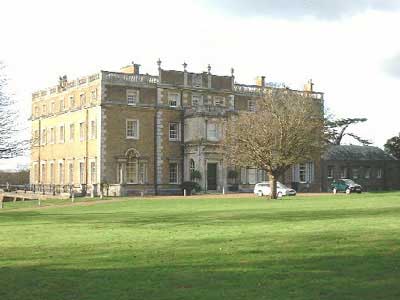
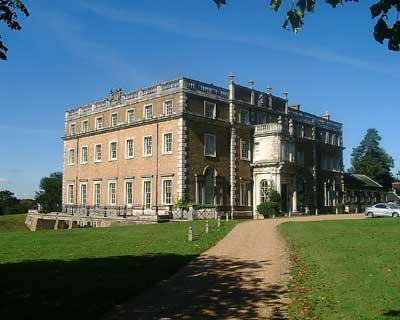 Peper Harow House
Peper Harow HouseThe Original Mansion was not even in the present ones position, from old foundations found in 1999 when mains services were being laid, it is thought to have been about 50-100 yards further West.
On the death of Earl Midleton the Peper Harow Estate and a large part of Shackleford that they owned was sold at auction in 1944.
This was second of the great estates in the area to be broken up within three years.
Then it became a rehabilitation centre for children for several years, then it suffered extensive damage when one of the children set fire to it and the top two floors were gutted and never re-opened.
In 1998 the house was sold to a developer and split into nine flats.
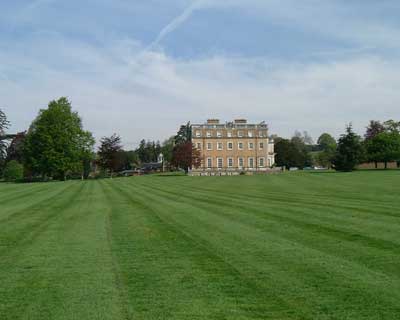
The parish of Peper Harow is said to have been named after a proprietor called Pepard or Pipard, in about 1100 A.D.
It is referred to as Piperherge in the Domesday Book and it is stated
to be owned by Walter Fitz Other, Castellan of Windsor.
Since then there is an unbroken record up to the present day of the
estate's owners, many of whom held high positions in the service of the king
or queen of their time.
One owner on the other hand, Sir Bernard Brocas, was beheaded
on Tower Hill in January 1400 for plotting against King Henry IV.
The estates were forfeited to the Crown but later restored to Sir Bernard’s
son and remained in the Brocas family for a further 170 years.
Passing through the hands of Ralph Peckshall, Master of the Buckhounds to
Edward IV, so to his son and various other owners, the estate came into the
ownership of John, Earl of Clare, who had to have a special Act of Parliament
passed to authorise its sale to Philip Frowde, postmaster-general in the reign
of Queen Anne.
From him it was bought, in 1713, by Brodrick, afterwards created Viscount
Midleton and Speaker of the Irish House of Commons.
What the house was like in his time we have no record as it was completely
rebuilt in something like its present form by the Third Viscount, though the
work was not completed until after his death in 1765.
The estate remained in the Brodrick family in unbroken succession to the
9th Viscount Midleton, who was responsible for the additions to the house
which brought it to its present size in 1930.
So it remained until after the Second World War, in which it was used as
the headquarters of the Canadian Ordnance Corps.
In this house a large part of the planning for the Dieppe raid and the
Normandy invasion was carried out.
After the death of the 9th Viscount Midleton, by then raised to the title
of Earl, the house was sold by his son to the managers of Park House School
and the farm and largest part of the lands to Mr Fuller.
As stated earlier, the house as we know it today was not conceived or begun
until the time of the third Viscount Middleton, nor finished until some time
after his death in 1765.
It was designed by Sir William Chambers, architect of Somerset House in London.
His first drawings show a house 80 ft by 88 ft, with only two stories between
basement and hipped roof.
These measurements were adhered to in the building but alterations to the
arrangement of rooms within the outline were made before completion of the
work.
The original estimate of the cost was £8,180, of which the principal items were:
Brickwork
£2,253 0s 0d
Portland stone
£1,208 13s 8d
Firr and Labour in floors and roof
£1,179 5s 0d
Westmoreland slating
£336 0s 0d
Lead for roof, gutters, water pipes, etc. £386 10s 0d
The final bill was for £9,912 10s 51/2d, but by the completion of the
work only about £900 remained to be paid as payments had been going out
since the beginning of the project.
The bill included fees to Samuel Alken, wood-carver and Joseph Wilson, R.A.,
sculptor, for work on door frames, chimney pieces, etc.
He also included the cost of painting and decorating, which must have been
considerable.
We know that the ceiling of the drawing room (later Gould Houseroom) had six
coats of paint, green on a purple ground with a white ornamentation.
That of the dining parlour, later Godfrey Houseroom, had five coats of green
with white ornamentation, while the ‘ground to centre’ in this room was
'seven times done, finished in Lalock colour’.
The ceiling of the library (later Spielman Houseroom) had a scheme of grey
on a pink ground. Decoration in the hall (Front Hall) included ‘three pictures
by Stubbs painted on purpose’.
Other examples of the care and consideration that went into the construction and finish are to be found in specifications on paper headed ‘memorandums relating to the finishing of the house at Peper Harow’, notably that for sound-proofing: ‘all the floors built on the principal storey and attick to be filled between the joists with cockle shells’.
Once completed, no major alterations were made to the house until the time of the late Lord Midleton, who succeeded his father in 1907. In 1913 the parapet was taken down, laid carefully around the house while a third story with a low pitched roof was added in place of the old attics, and then replaced.
The coming of the school in 1950 brought further changes not so much to the
outward appearance of the house itself but the grounds in which it stands.
With the laying down of Park Avenue and the erection of houses for staff,
each taking a parcel of land for a private garden, has almost disappeared
the last trace or what was an exceptionally beautiful leisure garden, stocked
with many rare trees and shrubs, stretching from the house right up to the
wrought iron carriage gates at the northern end of the estate.
In its place, besides the staff houses, a lawn tennis court was laid down,
a new sick bay added for the school and the old conservatory was converted
to a gymnasium.
Written by John L Ranger, former resident of Park House

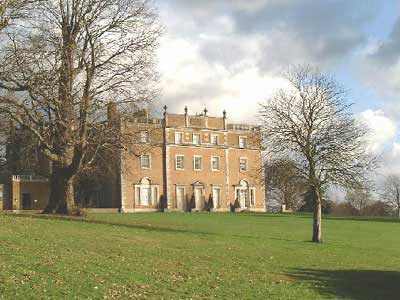
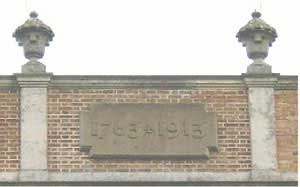
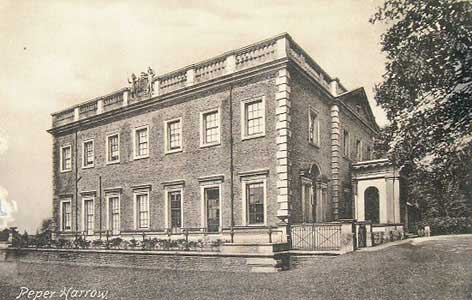
From an old postcard showing Peper Harow House after the porch was added about
1843 but before the top third floor was added in 1913.
Note the pediment over the front door, that was replaced by a facade and the
porch extended up to the first floor.
In the development of the country house the importance of Peper Harow is its
representation of the personality of Sir William Chambers. He directed ripe to
consolidating and refining the English tradition deriving from Inigo Jones, in
relation to his firmly held classical principles and familiarity with French
practice, to which he brought the best trained of his time.
His influence was exerted through intimacy with the young King, to whom he had
been architectural tutor, and which furthered the foundation of the Royal
Academy; through his books and pupils; and above all by his official
architecture as Survey General, notably Somerset House.
His country house practice was small compared with that of Paine or Adam, for
the most part in the shape of adjuncts and alterations. His proposals for
Harewood (c. 1755) being rejected, the design of its terminal pavilions was
adapted to that of th Casino at Marino, near Dublin, c 1780, which best
represents his genius, Elsewhere he was apt to be under the necessity of
working in 'rococo' for which, although itwent against his principles, he
showed a marked flaire in the chinoiseries of Kew, though less in the gothic
rebuilding (under protest) of Milton Abbey, Dorset. He continued to the
neo-classical movement by his learned eclecticism and, as Mr Summerson remarks
of Somerset House, by his application of the 'French influence to ironing out
the bolder terms of English Palladianism'.
Peper Harow illustrates this aptitude in a country house of medium size.
The property, beside thr R.Wey near Witley. was bought in 1713 by Allen Broderick,
Lord Chancellor of Ireland, created Viscount Midleton oc Co. Cork in 1715. His
Son, in the year of his death, 1765 procured sketch designs from Chambers for
a new house. A copy of the plan, which remained there, is giver in Fig.209;
a S.E. elevation has two rows of seven windows and a hipped roof; and of the
N.W. shows the little porch and stretches of blank wall indicated in the plan.
This also shows that the principle fronts had the same emphasized centre and
Venetian windows that exist.
The present porch, however, was added by C.R.Cockerell, 1843.
As the plans were dated March, 1765, it is probable that little building was
then done. When the successor came of age in 1775, new estimates were obtained
from Chambers for work to cost £8,180 (brickwork £2,253, Portland
stone £1,208, floors and roof £1,179). In 1777 an 'Account with
Wm. Chambers' specifies the offices as costing £3,200; chambers,
basement and garrett £2,585; and for finishing the principle floor
£2,340. Extra to them were bills of Chambers's usual sculptors, Joseph
Wilton £202, Richard Hayward £186, and J.Alken £294, the
whole amounting to £9,912, of which only £894 was outstanding.
The need for more rooms was met by substituting for the pitched roof a third
storey carrying the walls up into a parapet with balustrade, which in the
entrance front, takes the form of a podium resembling Taylor's central feature
at Heveningham (Fig.336).
The Hall (Fig.205) is typical of Chambers's restrained fomality in applying
the Doric mode (the Order itself is absent) to an interior. The ornament of
drapery festooned between paterae and bucrania is supplemented in the
chimneypiece with trophies of implements (Fig.212).Its surmounting pedastal
carries a bust said to be of Marlborough, repeated in a medalliion above -
the other medallion represent bewigged contempories.
The fine mahony doors used throughout cost 10s. per foot (or 6s. 6d. if
dummies). The chimneypieces carved by Wilson are in the Old Dining Room
(Fig.207) and Drawing Room (Fig.211). The latter is specified as Chambers's
design and as having the pilasters 'feneer'd with verd-Antique and inlaid
flutings of do., the Tablet of Bacchus anf Tyger'; the cost £118. Four
rooms have ceilings designed by Chambers. of which that in the Drawing Room
(Fig.208) is typical of his manner, though emballished with little devices
painted during Pugin's alteration by Willaim Evans.
Its original colouring, in six coats, is given as being purple and white.
That of the Dining Room was green and white, and of the Library grey,
with a pink background. The Hall and Staircase best preserve Chambers's
effect of a white design against a plain coloured ground. with, in the
latter, the additional grace of simple scroll-pattern balustrade. The painting
by Stubbs see over the Drawing Room fireplace is one of three 'painted
on purpose' to surmount the Dining Room doors. The best bedchambers were hung
with 'Indian' papers, in one case specified as 'cut out Indian papers', as
at Saltram (Fig.260).
Lady Midleton herself worked several of the carpets and we learn that she
'intends working chairs'; but for the principle rooms she was recommended.
probabley by Chambers. 'to go to Moore's manufacture near Moor Fields'.
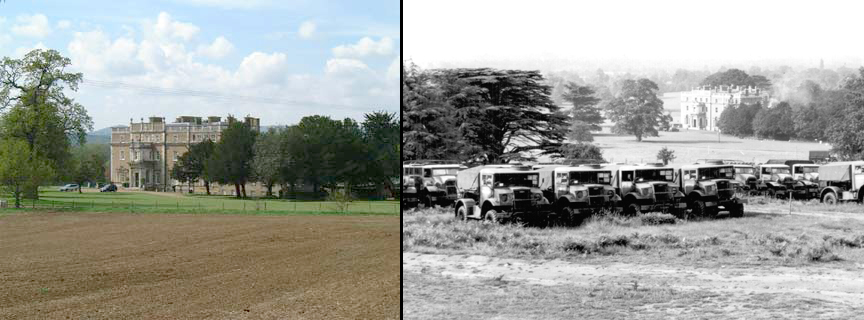 Now and Then
Now and Then
A Now and Then view of trucks parked in neat rows in readiness for the Normandy invasion.
 Account of a WW2 Mitchell Bomber FW268 EV-O crash on Shackleford Heath August 29th 1944
Account of a WW2 Mitchell Bomber FW268 EV-O crash on Shackleford Heath August 29th 1944
Lieutenant Cees Waardenburg DFC and Flying Officer H.Payne had taken off from Dunsfold aerodrome in Mitchell Bomber FW268 EV-O on a aircraft test flight, and after flying low over a line of trees, the tail clipped a tree and the aircraft flicked over onto its back and spun into the ground by a Canadian Army vehicle park on Shackleford Heath.
Extract from a book giving full account of the enquiry of Air crash 29th August 1944
Many "hold-ups"
"Gee, what a way to go and get married," commented a guest at one of the
strangest receptions ever held in this country. It took place in the
spacious Peper Harow Park, near Godalming, on Wednesday morning.
The happy couple, Private Lloyd Trottier, Canadian Army, and Private
Christine Weed, of the C.W.H.C., both members of the Canadian army show
'Rhythm Rodeo', had decided that at their wedding should be as spectacular
as the show.
They tried to arrange for the ceremony to be performed in the Big Top
with everyone, bride, groom, chaplain and guests, on horseback.
Unfortunately, the laws of the country said otherwise. When Lloyd applied for
a marriage licence the Guildford registrar, Mr George W Catt, said that the
marriage would not be legal unless it was held in a registered building
which, he contended, the tent was not.
Undaunted, the couple decided that the ceremony should take place in the
Register Office and that afterwards they would hold a wedding march, on
horses, and the open-air reception at Peper Harow.
The time fixed for the ceremony at Guildford was 11:00am on Wednesday.
The bride was driven up in a decorated station wagon and was attended by
her friend Private Joyce Evoy, C.W.A.C. The best man was Lance-Corporal Jack
Monoogian.
After the ceremony the happy couple were driven back to Peper Harow Mansion,
formerly the home of Lord Midleton, where they changed into their 'western'
outfits. Outside on the large lawn guests, some 40-odd 'cowboys' and as many
attractive C.W.A.C.s, waited until the bride and her groom made an appearance
riding their horses. The guests, all on horses, formed up at the rear at as
the C.W.A.C.s sang and whistled the Wedding March as the procession rode down
the full length of the lawn.
The producer of Rhythm Rodeo, Lieutenant-Colonel Rai Purdy, with the rodeo
director, Lieutenant-Colonel Kit Carson, congratulated Private and Mrs
Trottier on behalf of the company, and at that moment an old covered wagon,
drawn by four horses, came into view. It stopped in front of the couple and
a large iced cake was produced from the interior. On top of the cake, which
the bride cut with a German dress sword captured on the Continent, was a
silver horseshoe. The guests came by on their horses to receive a piece of
cake and wish the happy couple good luck. Later, Private and Mrs Trottier
left for a honeymoon in Guildford.
The bridegroom told an Aldershot News reporter that they did not want to
'show off' but wanted their wedding to be as spectacular as the show.
The Guildford registrar told the Aldershot News, "I've certainly had some
strange experiences, but I think this beats them all. They wanted me to marry
them while mounted on a horse and I'm quite sure I wouldn't have known which
side to mount the animal."
(story from Shackleford.org)
goto to Top
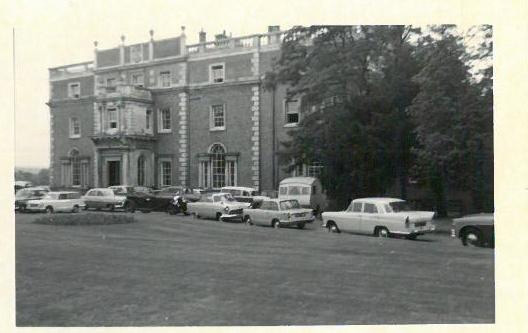
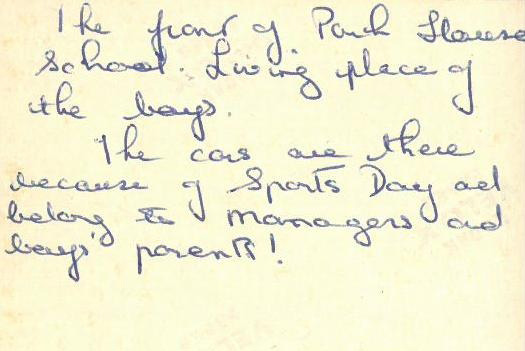
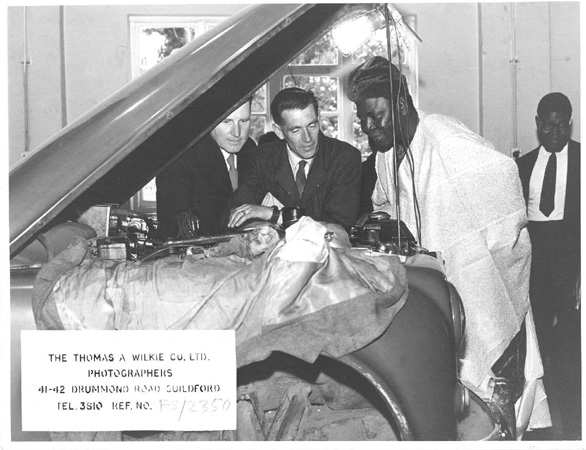 The Autoshop where the students were taught motor mechanic skills.
The Autoshop where the students were taught motor mechanic skills.